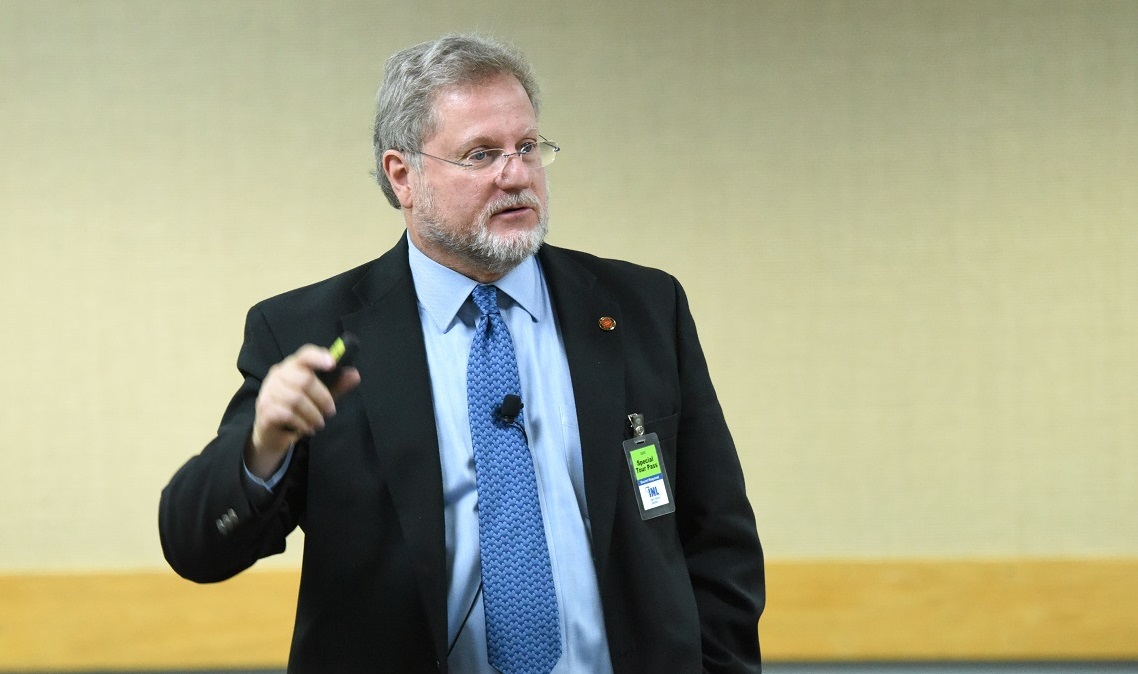Energy is cheaper than it has ever been. On the face of it that sounds like great news, but there’s a catch, says James Conca, a Ph.D. geochemist and science contributor to Forbes, the widely read business magazine.
While energy is abundant and cheap, thanks largely to the shale gas boom of the last 15 years, the United States’ infrastructure is long overdue for an update, said Conca, who visited Idaho National Laboratory to take part in its Nuclear Science & Technology Distinguished Seminar Series for employees.
Although he is an outspoken advocate of nuclear energy, giving a pro-nuke talk to INL managers and scientists would be “preaching to the choir.” Conca chose instead to talk about the nation’s aging energy infrastructure.
The demand for energy is projected to jump another 45 percent by 2040, but the U.S. is working with an infrastructure mostly built before 1980. New high-voltage transmission lines are needed to distribute energy from renewable sources of generation. More pipeline capacity is needed to distribute natural gas.
Meanwhile, Conca said nuclear energy, which he called the safest non-carbon source of electricity, continues its struggle to find love in the U.S. (This is not the case in China, which brought its first new AP1000 reactor online in October. While it will still be burning coal for a long time, China is going all-in on nuclear energy, with 400 new reactors planned by 2050.)
When he isn’t blogging for Forbes, Conca is the senior scientist and chief technical officer of UFA Ventures in Richland, Washington. He holds a doctorate in geochemistry from California Institute of Technology and designs remediation systems for the U.S. Department of Energy and industrial sites, emphasizing natural processes over costly engineered systems. He has been an affiliate scientist with Los Alamos National Laboratory since 1999.

While there are business reasons for importing oil and gas, the U.S. is basically energy independent in 2018. Between gas, coal and oil, there is a 1,000-year supply of fossil fuel underneath North America. “Energy is cheaper than ever,” Conca said. “With prices low and interest rates low, if you’re going to make big changes now is the time to do it.”
The costs of updating energy infrastructure will be considerable. With transmission lines that date back to the 1950s and 1960s, the electricity sector needs an estimated $5 trillion in investment by 2030. High voltage direct current lines are needed to carry power from wind and solar power plants, but another aspect that’s being widely overlooked is the need for large power transformers, which are failing at 10 times the rate they were 10 years ago. These weigh 400 tons each and cost millions of dollars.
Complicating matters is the fact that while they may be gung-ho on renewables and natural gas, Americans, especially residents of New England and the Middle Atlantic states, routinely vote down new transmission lines and pipelines.
In 2015, there were 3,571 power outages reported in the United States. A growing number of them are weather related. On the subject of climate change, Conca noted that the last 10 million years on Earth have been relatively cool. Whether the warming is natural or human-caused, “Biota don’t like change,” he said. It’s not the absolute amount of CO2 in the atmosphere, or the absolute temperature, both have been higher in the past. It’s just that they’re both changing so fast many species will go extinct, and humans will have a bunch of problems.
Thanks to the gas boom, U.S. carbon emissions are at a 27-year low. “We’ve gotten very good at getting (gas) out of the ground,” he said. Plenty of old coal plants are being retrofitted with gas turbines, which can be brought online in a year. The problem is getting gas to them. While the public has an aversion to new pipelines, old decaying pipelines can be replaced. With permits already in place, one solution might be to “supersize them,” e.g., replace 26-inch pipes with 42-inch pipes, which would allow five times the gas to move through.
If the United States wants to spend the money it will cost to build a new energy infrastructure between now and midcentury, the costs and benefits play out differently depending on which scenario is followed. A system that consists of one-third renewables, one-third fossil fuel and one-third nuclear would cost about $14.4 trillion total, with $3.4 trillion in capital investment up front. However, the health savings likely to be realized through burning less gas and coal have been forecast to amount to more than $2 trillion.
“There’s a lot of other things going on besides straight cost,” Conca said.
The Human Development Index has reported that it takes between 3,000 and 6,600 kWh for a person to have a good life. “Electricity is the cheapest fuel there is,” Conca said. Nuclear requires two square miles to create 1 billion kWh in a year, compared to 10 square miles for coal and 19 square miles for gas.
“We’re not being ambitious enough,” Conca said. “Energy will be cheap for the next two decades.”





